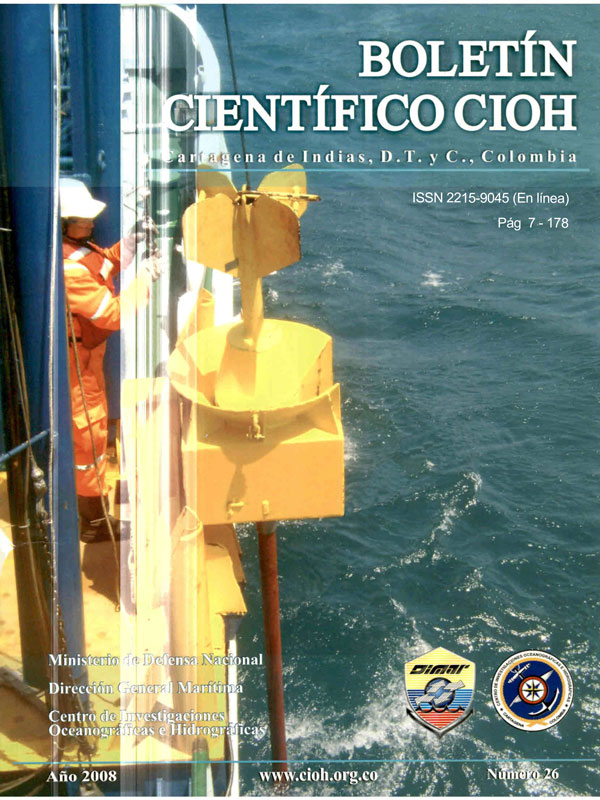Sea level behaviour on Colombia’s Caribbean coast line
DOI:
https://doi.org/10.26640/22159045.172Keywords:
Sea level, tide, tidal prediction, tidal constants, statistical analysisAbstract
The sea level behavior was studied at Cartagena, Coveñas and Santa Marta areas, three important cities of Colombia's continental region in the Caribbean. The tide (due to astronomical forces) and the non tidal residual were analyzed by separate. Tidal series were predicted by harmonic analysis, using in situ sea level series or generated by a long wave numerical model with tide information from a worldwide database as boundary conditions. The non tidal residual was obtained subtracting the tide from in situ sea level series. Series of non tidal residual were generated using statistical simulations, which were added to the tide series to obtain the expected sea level behavior that was presented as mean and extreme patterns. Homogeneity was founded in the tide behavior at the area of interest, catalogued as microtidal, having also a range between the maximum and minimum values of the same magnitude as the range of the no tidal residual, which also presented higher values toward the Greater Antilles than on the south-western Caribbean, due to the more frequent transit of tropical storms and hurricanes. Differences of the order of centimetres were founded on the heights of the mean and extreme patterns of sea level at the three locations studied.Downloads
References
[2] Lerma A. Variabilité du niveau de la mer de 1950 à 2000 et risque associé aux épisodes de mar de leva pour la presqu'ile de Bocagrande (Carthagène des Indes, Colombie). Thèse de Master 2. Université de Paris 1 Panthéon Sorbonne; 2008.
[3] Torres R, Gómez J, Afanador F. Variación del nivel medio del mar en el Caribe colombiano. Boletín Científico CIOH 2006; (24): 64-72.
[4] Dirección General Marítima DIMAR. Procedimiento técnico para establecer la línea de más alta marea en aguas abrigadas cuando no se tienen registros instrumentales. Cartagena (Colombia); 2006.
[5] Universidad de Hawaii, Centro del Nivel del Mar. Datos disponibles en http://uhslc.soest.hawaii.edu/.
[6] Organización Oceanográfica Internacional OHI. Manual de hidrografía. Capítulo 5. Nivel del mar y flujos. Publicación M-13; 2005.
[7] Pawlowicz R, B Beardsley, S Lentz. Classical tidal harmonic analysis including error estimates in MATLAB using T_Tide. Computers and Geosciences. 2002; 28: 929-937.
[8] Foreman M. Manual for tidal height analysis and prediction. Institute of Ocean Sciences, Patricia Bay, Victoria BC. Pacific Marine Science Report 1977; 77-10.
[9] Grupo de Ingeniería Oceanográfica y de Costas de la Universidad de Cantabria - GIOC. Manual de referencia modelo numérico H2DII. Ministerio de Medio Ambiente y Universidad de Cantabria. Santander (España); 2001.
[10] Andersen O, Woodworth L, Flather A. Intercomparison of recent global ocean tide models. J. Geophys. Res., 1995; 100 (C12), 25, 261-25, 282.
[11] Otero L. Aplicación de un modelo hidrodinámico bidimensional para describir las corrientes y la propagación de la onda de marea en la Bahía de Buenaventura. Boletín Científico CCCP2005; (12): 9-21.
[12] Grupo de Ingeniería Oceanográfica y de Costas GIOC. Atlas de Inundación del Litoral Peninsular Español. Documento Temático. Ministerio de Medio Ambiente y Universidad de Cantabria. Santander (España); 2002.
[13] National Oceanographic and Atmospheric Administration, Tide and current glossary. U.S. Department of commerce. Silver Spring MD; 2000.
[14] Ortiz J. Huracanes y tormentas tropicales en el mar Caribe colombiano desde 1900. Boletín Científico CIOH 2007; (25): 54-60.
[15] Kjerfve B. Tides of the Caribbean Sea. J Geophys. Res., 1981; 86: 4243-4247.
[16] Lozano A, Para B. Análisis armónico y predicción de la marea para la Bahía de Cartagena. Trabajo de grado. Facultad de Oceanografía. Escuela Naval Almirante Padilla. Cartagena (Colombia); 1993.
[17] Pugh D. Changing sea levels: effects of tides, weather and climate. Cambridge University Press. U.K.; 2004.
Downloads
Published
Issue
Section
License
Attribution — You must give appropriate credit, provide a link to the license, and indicate if changes were made. You may do so in any reasonable manner, but not in any way that suggests the licensor endorses you or your use.
NonCommercial — You may not use the material for commercial purposes.
NoDerivatives — If you remix, transform, or build upon the material, you may not distribute the modified material.
No additional restrictions — You may not apply legal terms or technological measures that legally restrict others from doing anything the license permits.










